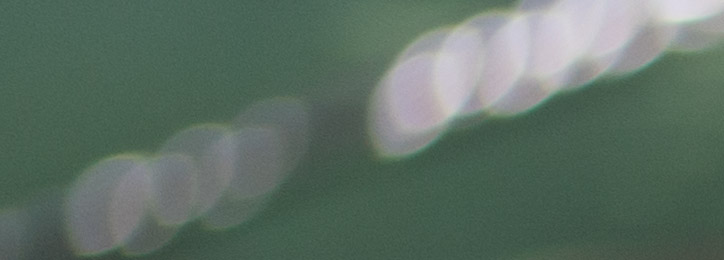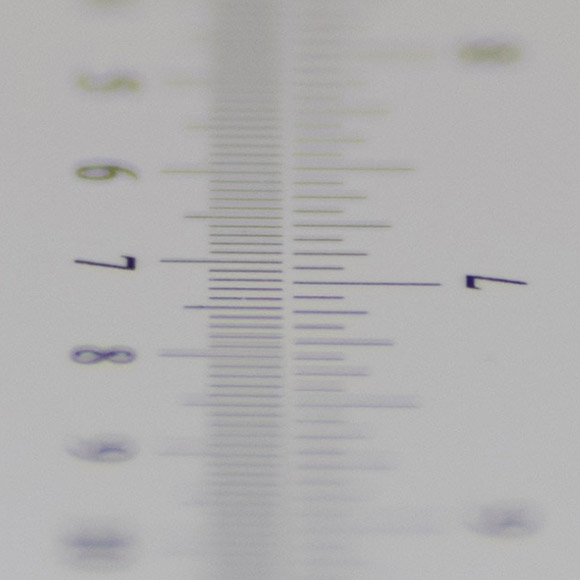|
Sony FE 85mm f/1.8 ( SEL85F18 ) - Review / Test Report - Analysis |
|
Lens Reviews -
Sony Alpha (Full Format)
|
|
Page 2 of 2

Distortion
Image distortions are very well controlled. The RAW distortion is already low at just ~0.6% (pincushion style). When activating image auto-correction, the distortion is negligble.
Move the mouse cursor across the image for viewing the distortion chart with auto-correction.
Vignetting
In the Zeiss Batis 85mm f/1.8 review we were somewhat concerned by the very high vignetting - a Zeiss trademark. The Sony FE 85mm f/1.8 isn't great either in this respect but it does a better job nonetheless. The RAW vignetting is clearly visible with a light falloff of 2.2EV (f-stops) at fully-open aperture. Stopping down to f/2.2 reduces that quite a bit but it takes f/2.8 to push it below the 1EV (f-stop) mark. If you use image auto-correction, the vignetting is reduced by 1.3EV to ~0.9EV (f-stops) at f/1.8 (thus the image noise increases accordingly) which is quite acceptable.

MTF (resolution)
It may come as a surprise to some but the Sony FE 85mm f/1.8 is tack sharp and it rivals the Zeiss Batis in this respect. The goodness starts straight at f/1.8. The quality is already so high that the image quality doesn't really increase anymore when stopping down. Interestingly the characteristic also mirrors the Zeiss lens at smaller aperture settings. Diffraction kicks in "too late" thus it seems as if there's an inaccuracy in the aperture mechanism - this may also explain why we had to compensate for an overexposure during our vignetting tests at these settings.
The centering quality of the tested sample was good. Field curvature is minimal.
Please note that the MTF results are not directly comparable across the different systems!
Below is a simplified summary of the formal findings. The chart shows line widths per picture height (LW/PH) which can be taken as a measure for sharpness.
If you want to know more about the MTF50 figures you may check out the corresponding Imatest Explanations
Chromatic Aberrations (CAs)
The Zeiss lens produces a low amount of lateral CA (color shadows at harsh contrast transitions) starting with an average CA pixel width of ~0.7px (borders) at f/1.8 increasing to ~1.2px at f/11 onward. This is usually not disturbing.

Bokeh
Outstanding sharpness is one thing but fast lenses are also about producing a shallow depth-of-field. For many users, a nice bokeh (rendition of the out-of-focus blur) is a major purchasing criterion.
The Sony lens continues to have a run here. Out-of-focus highlights are beautifully rendered with a very smooth inner disc and just very slight outlining. The circular shape remains intact at f/2.8. An edgy aperture shape starts to kick in at f/2.8.
 Near the borders, the circular discs deteriorate to "cat eyes". This is more pronounced than on the Batis lens but the inner zone is certainly smoother.
Near the borders, the circular discs deteriorate to "cat eyes". This is more pronounced than on the Batis lens but the inner zone is certainly smoother.
 The general blur in the critical focus transition zone is pretty much perfect for a conventional lens. The background blur (to the left below) is marginally smoother than the foreground (right) here.
The general blur in the critical focus transition zone is pretty much perfect for a conventional lens. The background blur (to the left below) is marginally smoother than the foreground (right) here.

Bokeh Fringing
So-called bokeh fringing is an effect that occurs around the focus point (on the Z-axis). It's visible as halos of different colours in out-of-focus areas - magenta (red + blue) in front of the focus point and green beyond.
The Sony FE 85mm f/1.8 may feature an ED element but it isn't corrected for this type of fringing. The coloured halos are clearly visible at large aperture settings and traces remain at f/4.
If you traverse through the aperture range below, you will also observe that the focus remains static (thus no residual spherical aberrations).
|
Move the mouse cursor over the f-stop marks below to observe the respective LoCAs
|
| f/1.8 |
f/2.2 |
f/2.8 |
f/4 |
|

|
Sample Images
Coming later this time. Sorry.
The Competition
Those interested in the Sony FE 85mm f/1.8 will probably not really consider "the brick" - the Sony FE 85mm f/1.4 GM is shown to the left below. A more interesting question may be whether it's worth to upgrade to the Zeiss Batis 85mm f/1.8 (center below). Honestly, the upgrade story is rather weak. The sharpness of both lenses is comparable and the Sony lens even has an edge in some of the other characteristics. The Zeiss lens features an image stabilizer which may be a plus depending on the camera body but then most Sony cameras feature in-body stabilization anyway. The Zeiss lens can have an edge at very close focusing distances though.
 Visual comparison courtesy of camerasize.com.
Visual comparison courtesy of camerasize.com.
Verdict
Moderately fast (as opposed to insanely fast) 85mm or 100mm lenses are generally an easy choice unless something went terribly wrong during the design phase. Still, honours where honours are deserved - the Sony FE 85mm f/1.8 is an epic lens. It combines outstanding sharpness with a buttery bokeh which is a quite rare combination actually. Lenses that are pushing sharpness are usually not quite as smooth when it comes to the quality of the bokeh. Lateral CAs, as well as image distortions, are low. In terms of weaknesses, we'd list the bokeh fringing - albeit it isn't any worse than the competitors, a fairly high RAW vignetting at f/1.8 and a reduced quality at very close focusing distances (if that matters in this lens class).
The build quality of the lens is surprisingly high considering the fact that the lens is primarily targeting the consumer market. It's a tightly assembled, all-metal construction and it's weather-sealed, too. Manual focusing (by wire) works nicely and the auto-focusing speed is above average.
And to complete the nice story, all that is available at a very affordable price. Therefore, unless you really need that extra speed of a 85mm f/1.4 (and most don't really), we finish with ... highly recommended!
|